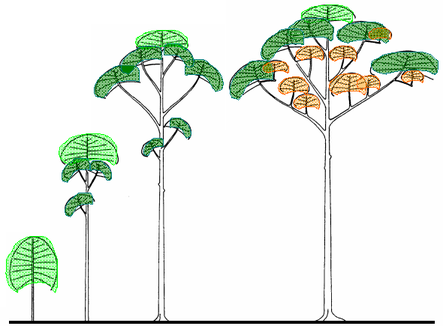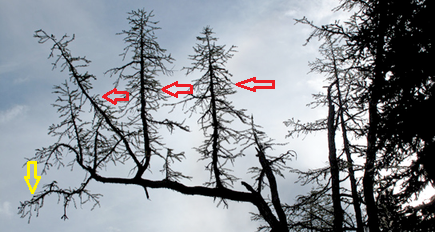Preliminary Course
Botany. Architectural Analysis
Architectural Unit
Reiteration
-
The reiteration process plays a key role in mature tree crown construction.
-
As first stated by Oldeman, (1974) the reiteration process may involve the expression of the total architectural
unit, so called complete or total reiteration, or the expression of part of the developmental sequence
duplicating only part of the species architectural unit, so called partial reiteration.
Moreover, reiterated complexes may originate from dormant meristems. In this case such complexes are called proleptic or delayed reiterations.
By contrast, reiteration may result from a shift in the functioning of the apical meristem of a growing shoot that will finally produce a low differentiated structure, i.e. a branch apex that after some time of functioning gives rise to a supernumerary trunk.
In this case, the reiteration is described as sylleptic, or immediate reiteration.
Either of these delayed or immediate reiterations may be qualified as total or partial.
Reiteration was originally only considered as an opportunistic process, with two main origins.
- Adaptive reiteration is a response to an increase in resource levels.
- Traumatic reiteration is a response of a plant after it has been damaged and lost a major part of its structure.
However, it is now demonstrated that, beside these cases of opportunistic reiteration, the same process of repetition may be involved in the inherent growth pattern of a species and occur automatically during plant development after a definite threshold of differentiation.
This latter case is a common feature of tree development and crown construction and is referred to as automatic or sequential reiteration. It has also be shown that environmental conditions affect the reiteration process. In many cases, resource pressure limits the process. Immediate reiteration can be considered as a meanmean allowing trees to optimize space occupancy according to available energy.

Stages of development involving reiteration. The case of Shorea stenoptera (Drawings C. Edelin, CIRAD)
Left. The young tree: the architectural unit.
Middle. Adult trees. Two steps of immediate automatic reiteration in crown establishment.
Right. The mature tree. Delayed reiterations appearing at older stages.
Traumatic reiteration is a delayed process, since it arises from dormant meristems awakened after the traumatism.
It can also be total or partial.

Traumatic reiteration on Alpine Larch. (Photo courtesy M. Kauffman, BACKCOUNTRY PRESS)
Red arrows: Complete traumatic reiterations.
Yellow arrow: Partial traumatic reiteration.
The occurrence of reiterated complexes seems to be a move backwards within the plant's developmental sequence.
For instance, the reiterated complexes resulting from the transformation of a branch, or from the development of a dormant meristem, implies that the plant expresses again the juvenile growth pattern of the organism developed from seed.
This is well illustrated in cases of regeneration in which, when a trunk is cut, sprouts resembling young trunks are formed from the stump, whereas reiterated complexes that develop after a branch has been damaged have an architecture similar to that of that branch.
Bibliography
Oldeman R.A.A. 1974. L'architecture de la forêt guyanaise. Mémoire no.73. Paris: O.R.S.T.O.M.
Edelin C. 1977. Images de l'architecture des conifères. Thèse de Doctorat (Sciences biologiques option Biologie végétale). Université de Montpellier II, 255 p.
Barthélémy, D., Caraglio, Y. 2007. Plant Architecture: A Dynamic, Multilevel and Comprehensive Approach to Plant Form, Structure and Ontogeny. Annals of Botany, 99 (3) : pp. 375-407 19 (access to paper and pdf)
Definition
Reiteration
Botany. Botanical concept used to describe local or global architectural structure duplication. First defined by Oldeman, 1979.Definition
Architectural Unit
Botany. The architectural Unit of a given plant species is the specific expression of its architectural model. The architectural Unit of a plant can be seen as a hierarchical branched system in which the axes can be grouped into categories according to their morphological, anatomical or functional distinctive features (Barthélémy et Caraglio, 2007).See also: Architectural Model.
